Clancy Tucker's Blog, page 241
November 10, 2015
11 November 2015 - THE LION TREE OF SERENGETI
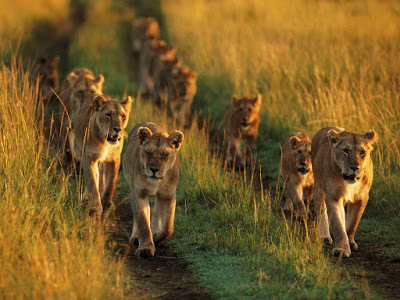
THE LION TREE OF SERENGETI
G'day folks,
Always great to catch animals in the wild. Mm ... Check out these lions napping up a tree in Central Serengeti, Tanzania.

At least 15 of the beasts were caught on camera lounging on the branches of a sturdy tree in Central Serengeti, Tanzania.
But while it might look as though they were using the vantage point to seek out prey, photographer Bobby-Jo Clow, from Dubbo, Australia, revealed the laid back pride were actually trying to escape flies living in the long grass.
The lions were caught on camera lounging on the branches of a sturdy tree
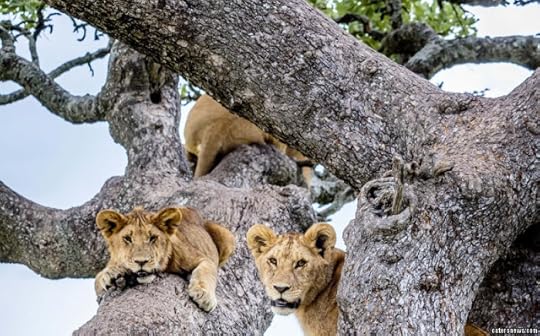
Bobby-Jo, 32, said: “I was leading a photographic safari in the Serengeti and on our first official day in the park we came across this incredible sighting.
“Our guide spotted the pride in the trees, and luckily we were able to get close enough to the lions to create some really unique images.
“We were close enough that we could hear their vocal interaction and also hear some of them snoring in the tree.
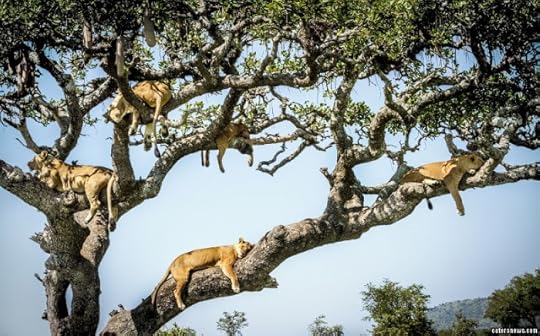
The lions can be seen enjoying some relaxing time in the safety of a high tree
“At one point I counted 15 lions in the tree – it was an incredible sight.
“It was also very comical at times as the lions appeared rather clumsy whilst moving and repositioning themselves in the tree. One lioness had an incredibly rotund belly and she was letting it all hang out whilst perched on the tree.
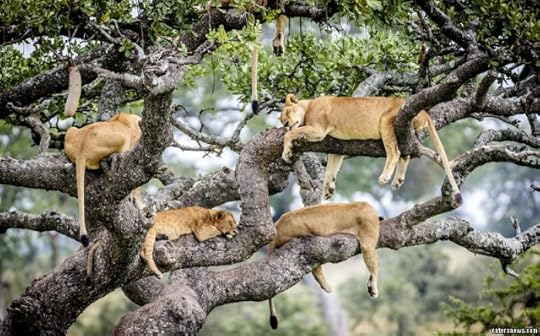
The laid back pride were trying to escape flies living in the long grass
“Our guide informed us that due to the recent rains the grass was quite long in the Serengeti and that lions climb the trees to escape the insects that thrive in the long grass. When your guide gets his camera out and starts taking photos you know you have something special in front of you.”

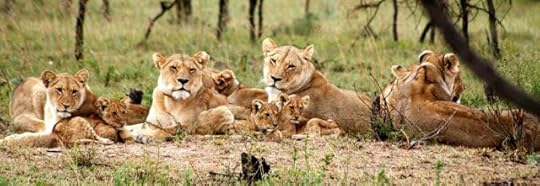

Clancy's comment: Some great shots by another Aussie photographer. Well done, Bobby-Jo. Grrrrrrrrrrrrr!
I'm ...


Published on November 10, 2015 02:41
November 9, 2015
10 November 2015 - DWIGHT EISENHOWER
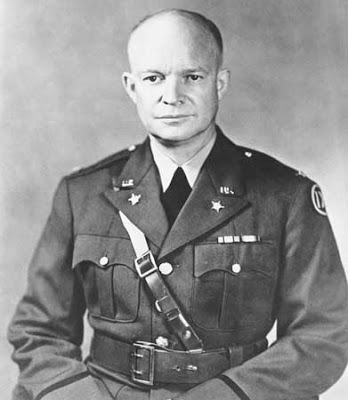
DWIGHT EISENHOWER
G'day folks,
Welcome to some background on a well known general. Dwight David “Ike” Eisenhower (October 14, 1890 – March 28, 1969) was a five-star general and Supreme Allied Commander during D-Day invasion of France in 1944. He was also the 34th President of US from 1953-1961.
David was born to a large family (he had 6 brothers) in Kansas in 1890. From an early age he was interested in outdoor sports and military history. Despite his mother’s objection to war, he continued his military studies and later joined the military academy at West Point.
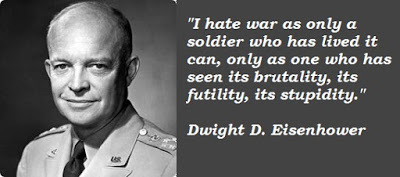
He graduated in 1915, but to his disappointment was initially denied permission for an overseas posting. In 1918, he finally went to France, but, to his great disappointment, didn’t see any action; instead he was responsible for a training a new tank corps.
After the war, along with George S.Pattonhe became more interested in tank warfare, investigating their optimal use in a fast moving war. However, the military top-brass were dismissive of this new-innovation and Dwight had to hold back from publishing more work on the use of tanks.
In the inter-war years, he served with a succession of generals, such as J.Pershing, Douglas MacArthur and George Marshall. Due to his strong administrative qualities, he was gradually promoted, reaching brigadier General in October 1941.
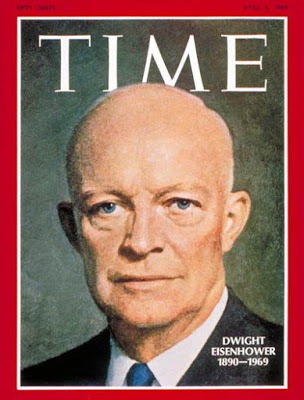
By the end of November 1942, Eisenhower had been appointed the Supreme Commander of the Allied Force in North Africa, and he was given command over Operation Torch seeking to remove the axis forces from North Africa. After the defeat of the axis in Africa, he also oversaw the successful invasion of Sicily, and later Italy.
By the end of 1943, President Roosevelt decided that Eisenhower would make the best candidate to be the Supreme Allied Commander in Europe, this meant Eisenhower would have overall command for the forthcoming D-Day invasion, codenamed Operation Overlord.
This gave Eisenhower as many political difficulties as military. But, Eisenhower proved adept at managing the different egos and Allied nations involved in the assault on mainland Europe. He had to deal with prickly generals such as the British Bernard Montgomery, and fellow American General S.Patton. At one point, Eisenhower severely reprimanded Patton for slapping a soldier suffering from shell shock.
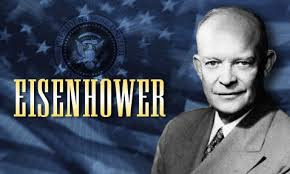
Eisenhower had the capacity to disagree strongly with generals and politicians, such as Winston Churchill, without ever threatening their relationship and the alliance. The D-Day invasion proved successful, though the advance on Berlin proved harder and more costly than many hoped. Eisenhower was always conscious of the personal cost involved, and was conscious of his responsibilities to individual soldiers, frequently visiting divisions of solider.
After the German surrender, Eisenhower was responsible for the Allied sections of occupied Germany. He sought to find evidence against leading Nazi’s and allowed more humanitarian aid into suffering German civilians.
In the aftermath of the Second World War, Eisenhower was initially hopeful that friendly relations could be maintained with the Soviet Union. However, by mid 1947, tensions between East and West increased and Eisenhower came to support the policies of Soviet containment.
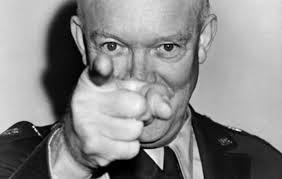
In 1952, Eisenhower was encouraged to stand as Republican Presidential candidate. Although previously not engaged in politics, he agreed to stand and campaigned on the simple slogan ‘I Like Ike’ becoming the first Republican candidate for 20 years to win office. He stood on a simple platform of anti-communism, anti-corruption, and anti-big government. He favoured a form of ‘progressive conservatism’ – maintaining and extending existing social security legislation, but trying to maintain frugal government spending.
Helped by a booming post-war economy, the 1950s was an era of prosperity and economic expansion and this helped maintain his popularity. One of his big achievements was the creation of an interstate highway, which improved motor transport between different cities.
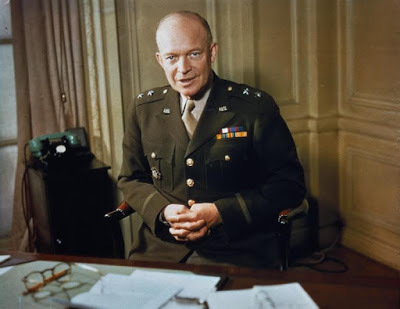
However, during his presidency cold war tensions remained. Attempts to halt the nuclear arms race came to nothing, and Eisenhower move the military to increased reliance on nuclear weapons rather than conventional weapons.
In 1954, Eisenhower articulated the ‘domino theory’ – The idea that if Communists were allowed to prevail in one country, it would soon spread throughout the region. This doctrine proved very important, as during this era, the CIA became increasingly involved in plotting foreign coups and working to undermine Communist and left-leading governments. This included restoring the Shah to power in Iran and plotting the bay of pigs invasion of Cuba, which was left to John F.Kennedy to carry out.
One of the great successes of his administration was signing an armistice in the Korean war in 1953. He also severely criticised his former Allies – Britain, France and Israel for their invasion of the Suez canal. The intervention of the Americans was key in creating a humiliating reverse for the British, French and Isreali’s. Eisenhower was a strong supporter of the United Nations, and used the UN to criticise the Russian invasion of Hungary.
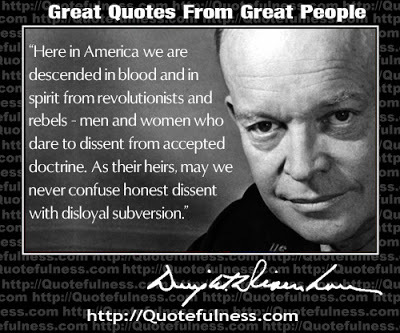
Despite a strong anti-communist foreign policy, Eisenhower became increasingly dismayed by the anti-communist ‘witch hunt’ of Senator McCarthy. Eisenhower covertly sought to undermine McCarthy’s influence.
On the issue of civil rights, Eisenhower sought to end segregation in the army. He also sent in state troops to Little Rock, Arkansas to defend the end of segregation in schools.
In his last speech, he both warned of the enemies abroad, and the misuse of power at home.
“We face a hostile ideology global in scope, atheistic in character, ruthless in purpose and insidious in method…” and warned about what he saw as unjustified government spending proposals and continued with a warning that “we must guard against the acquisition of unwarranted influence, whether sought or unsought, by the military–industrial complex.”
“we recognize the imperative need for this development … the potential for the disastrous rise of misplaced power exists and will persist … Only an alert and knowledgeable citizenry can compel the proper meshing of the huge industrial and military machinery of defense with our peaceful methods and goals, so that security and liberty may prosper together.”
Eisenhower married Mamie Geneva Doud of Boone, Iowa, on July 1, 1916. They had two sons, one of whom died in childhood of scarlet fever. Eisenhower declared himself to be a religious man, but not affiliated to any particular sect. He was instrumental in having the US adapt the motto ‘In God we Trust’ in 1956.

Clancy's comment: Interesting life. Interesting man.
I'm ...


Published on November 09, 2015 02:48
November 8, 2015
9 November 2015 - SOME FACTS ABOUT DANIEL BOONE

SOME FACTSABOUT DANIEL BOONE
G'day folks,
Daniel Boone was an American pioneer, explorer, a woodsman, and a frontiersman, whose frontier exploits made him one of the first folk heroes of the United States.
Daniel Boone’s name is synonymous with the American frontier, which he explored and helped open to settlement. A skilled hunter and trapper, Boone blazed trails through the wilderness, fought and befriended Native Americans and witnessed America’s transformation from 13 colonies to 23 states over the course of his lifetime. Get the facts on the legendary frontiersman, including how he became internationally famous and what he really thought of coonskin caps.
His family came to America to escape religious persecution.
In 1713, Boone’s father, a weaver and blacksmith, journeyed from his hometown of Bradninch, England, to the colony of Pennsylvania, established by William Penn in 1681 as a haven for religious tolerance. Like Penn, Squire Boone belonged to the Society of Friends, or Quakers, a group whose members faced persecution in England for their beliefs. In 1720, Squire married fellow Quaker Sarah Morgan and Daniel, the sixth of the couple’s 11 children, was born in 1734 in present-day Berks County, Pennsylvania. In the 1740s, two of the oldest Boone children wed “worldlings,” or non-Quakers, and were disowned by the local Quaker community. After Squire Boone refused to publicly apologize for the second of these two marriages, he too was kicked out of the Quakers. He subsequently left Pennsylvania with his family in 1750 and traveled by wagon to the colony of North Carolina, where in 1753 he purchased two tracts of land near present-day Mocksville.

Boone blazed a trail to Transylvania.
In 1775, Boone and a group of some 30 woodsmen left to complete a 200-mile trail through the wilderness to the Cumberland Gap—a natural break in the rugged Appalachian Mountains—and into Kentucky. Boone had been hired for the job by Richard Henderson, a North Carolinian who along with a group of investors planned to establish a colony called Transylvania in an area comprising much of present-day Kentucky and part of present-day Tennessee. After Boone blazed the trail, which became known as the Wilderness Road, he helped establish one of Kentucky’s earliest settlements, Boonesborough, which became Transylvania’s capital. The Transylvania colony was short-lived; in 1778, the Virginia General Assembly voided the deal Henderson had struck with the Cherokees for the land. Nevertheless, the Wilderness Road became the gateway by which an estimated 200,000 settlers journeyed to the western frontier by the early 19th century. Among those emigrants was Abraham Lincoln’s grandfather, who in 1779 traveled the Wilderness Road from Virginia to Kentucky, where America’s 16th president was born in 1809.
Boone was held captive by Native Americans.
In February 1778, while Boone was traveling with a group of Boonesborough men along Kentucky’s Licking River, he was captured by a group of Shawnees. The Indians took him to their village in Ohio, where he was adopted by Shawnee chief Blackfish to take the place of one of his sons who’d been killed. Boone, who was given the name Sheltowee, or Big Turtle, was treated relatively well by his captors—he was allowed to hunt and may have had a Shawnee wife—but they kept a close eye on him. In June 1778 he managed to escape and make his way back to Boonesborough, where he warned residents that the natives, upset because settlers had moved onto their Kentucky hunting grounds, were planning to attack. That September, over the course of nine days and nights, a group of Shawnees and other Native Americans laid siege to Boonesborough, but the outnumbered settlers managed to hold them off. The victory at Boonesborough helped spark a new wave of emigrants to Kentucky, some of them personally recruited and led there by Boone.

He was an international celebrity during his lifetime.
Boone was transformed from a local hero into someone who was internationally famous when his story was included in a book, “The Discovery, Settlement and Present State of Kentucke,” published in 1784. The book was written by John Filson, a Pennsylvania schoolteacher turned Kentucky land speculator, in an effort to lure settlers to Kentucky. The author, who interviewed Boone, presented the frontiersman’s adventures in what were supposedly his own words, although the embellished language belonged to Filson. The book proved popular in both America and Europe, where readers were captivated by Boone’s story. After Boone’s death in 1820, his legend continued to grow with the publication of such best-selling works as “The Biographical Memoir of Daniel Boone, the First Settler of Kentucky,” released in 1833. In this sensationalized account of Boone’s life, author Timothy Flint portrayed him as a ferocious Indian slayer who engaged in hand-to-hand combat and swung on vines to elude capture; in reality, Boone had friendly relationships with a number of Native Americans and claimed to have killed just a few of them.
Boone was unlucky when it came to real estate.
Although Boone helped open up Kentucky to thousands of settlers, he ultimately was unsuccessful when it came to securing his own piece of the pie. During the 1780s and 1790s, he worked as a surveyor in Kentucky while also investing in real estate. However, his efforts as a land speculator failed to make him rich. Boone ended up getting swindled in some deals and in other cases failed to properly register his land claims. He got hit with lawsuits for selling property to which he didn’t have valid title and also got sued for producing faulty surveys. Boone even received death threats after his testimony in various court cases resulted in people losing their land claims. Boone tried, but largely failed, at other business ventures as well. He owned a store and tavern in Limestone (present-day Maysville); served as a supplier of ginseng root (the market eventually collapsed, leaving him in debt); and bought horses with the intention of reselling them (before this could happen a number of the animals escaped). By the late 1790s, Boone had soured on Kentucky and decided to leave.

Later in life, he left the U.S.
In 1799, Boone, then in his mid-60s, moved with his extended family from Kentucky, which achieved statehood in 1792, to present-day Missouri, then under Spanish control and known as Upper Louisiana. The Spanish, who wanted to encourage settlement in the area, welcomed Boone with military honors and granted him 850 acres of land in the Femme Osage district, west of St. Louis. They also waived the requirement that all immigrants had to be Roman Catholic and made Boone a syndic, or magistrate, of the Femme Osage district, responsible for settling disputes among settlers.
In 1800, the Spanish ceded the Louisiana Territory to France, and three years later the U.S. gained control of it with the Louisiana Purchase. Boone subsequently lost his land claims because he hadn’t followed the proper procedures to gain permanent title to the land. After the frontiersman petitioned Congress, President James Madison signed a bill into law in 1814 giving Boone his 850 acres; however, he soon had to sell the property to pay off Kentuckians who’d heard the news about the grant and traveled to Missouri to collect on old debts. Missouri became America’s 24th state in 1821, a year after Boone’s death.
He didn’t wear coonskin caps.
Boone has often been portrayed sporting a hat made from the skin and fur of a raccoon, but in fact the frontiersman thought this type of headgear was unstylish and instead donned hats made from beaver. According to Boone biographer John Mack Faragher, the myth of the coonskin cap can be traced to a full-length portrait of Boone made in 1820 by Chester Harding, who authentically depicted the frontiersman wearing leggings, moccasins and a fringed hunting shirt and holding a beaver hat. The painting was displayed in the Kentucky capitol for several decades until it deteriorated. Harding later cut out Boone’s head and pasted it onto a different background; however, a record of Boone’s outfit was preserved thanks to artist James Otto Lewis, who had produced an engraving of Harding’s original painting. Lewis hired an actor, Noah Ludlow, to help sell prints made from the engraving, and when Ludlow later performed a show that required him to dress like a frontiersman he modeled his costume after Boone’s wardrobe in the engraving. Unable to find a beaver hat, he substituted it with a coonskin cap. Ludlow’s performances were a success and the coonskin cap’s association with Boone stuck.

Boone might not be buried in his official grave.
Boone died on September 26, 1820, in present-day Defiance, Missouri. He remained active into old age, unsuccessfully volunteering to fight in the War of 1812 and going on his last big hunt just a few years before he passed away. Boone was buried in a graveyard near Marthasville, Missouri, next to his wife, Rebecca. In 1845, the owners of a cemetery in Frankfort, Kentucky, convinced the Boones’ descendants to allow Daniel and Rebecca’s remains to be reinterred in the Bluegrass State. The Frankfort cemetery was new and its owners were interested in drumming up publicity; they also promised to erect a monument to Boone at the new burial site.
An elaborate reinterment ceremony was held, featuring the governor of Kentucky and other dignitaries. However, charges eventually surfaced that Boone’s Missouri grave had been poorly marked and the wrong remains were dug up and reburied in Kentucky. In 1983, a forensic anthropologist examined a cast made of Boone’s supposed skull before the reburial and announced it was possibly that of an African-American man rather than a Caucasian one. When a second forensics expert later studied the cast of the skull, though, she decided it wasn’t in good enough condition to serve as the basis for any scientific conclusions.

Clancy's comment: I remember watching a television series about this guy when I was a kid. It opened my eyes to nature, and was one of many shows that inspired me to see the world. And ... I did, and never regretted it.
I'm ...


Published on November 08, 2015 02:58
November 7, 2015
8 November 2015 - SharaLee Podolecki - Guest Book Reviewer

SharaLee Podolecki
- Guest Book Reviewer -
G'day folks,
Today I offer a book reviewer as my special guest. You know, the people we as authors try to stay up close and friendly with.
Welcome, SharaLee ....
1. TELL US A LITTLE ABOUT YOURSELF AND YOUR BOOK-REVIEWING JOURNEY: Well, I’ve been reading books for review since I was in high school. I would help our high school librarian categorize books for the school library based on reading level and content. It was something I really enjoyed doing. After high school, I discovered Goodreads, and started posting some reviews there. I started a degree in English Literature and found that reading books and analyzing them was something I was in love with and I knew that I always wanted to be doing it in some way. When I was pregnant with my daughter, I had a small unpaid position as a book reviewer for BTS eMagazine, and I remember thinking I was so stressed all the time with the pressure they put on me and the low quality of books I was expected to read/give positive reviews for, that I decided to leave BTS, open a WordPress account and start my own blog, centering around my own personal book reviews. It has been going well, and I also include some reviews that my husband, Graham, does on books I make him read. I like it better this way because I feel free to be more honest with each book and to have more time to review it properly. I also enjoy the comments some of my readers leave, and meeting other like-minded literary people. Sharing my love of reading has become such a joy. I can’t imagine not doing it.
2. WERE YOU A GOOD READER AS A KID?I was a very good reader. I read my first novel – Freaky Friday by Mary Rodgers – when I was only 5 years old, and I remember my mother getting annoyed because I could read the long words but kept asking her what they meant every five seconds!
3. WHY A BOOK REVIEWER?I’ve been blogging for years (I used to have a LiveJournal account in university), and I’ve been reading and talking about books for years. After a while it only seemed natural to put the two together. Also, if I continue to do this, I can put together a portfolio and possibly get published and paid for my literary criticism.
4. WHAT DO YOU ENJOY MOST ABOUT BEING A REVIEWER?Other than having my own blog and being able to review on my own terms, I really love discovering a hidden gem and helping get it out into a general readership awareness, I love the added knowledge of technique and what is and is not cliché it brings to myself as a writer, and I love getting to know writers from all over who write all sorts of things and are just as passionate about the written word as I am. It’s also incredibly gratifying if I have known the person’s work as it has progressed, when I can see it transform from a veritable tangled mess into a very well-written story or book. To see someone improve as a writer is an excellent feeling.

5. WHAT IS THE HARDEST THING ABOUT BEING A REVIEWER?Probably having to give someone really kind a bad review. I am an honest reviewer. I try to make my criticism constructive, but I firmly believe that lying to someone does not help them professionally, so I will always give my true thoughts on their work. This is extra hard when you have friends who thank that because you are a reviewer, you will automatically give them a good review. It can lead to hurt feelings when the other person doesn’t understand the professional nature of the review versus my personal feelings for them as a friend. So to all friends and future friends: If I say your writing is good, please believe me. I am not flattering you. I am telling the truth! And if I have a suggestion to better your work, please try to listen, because maybe I can see things you can’t.
6. WHAT WERE YOU IN A PAST LIFE, BEFORE YOU BECAME A BOOK REVIEWER?I took an online quiz, and it told me I was actually a fortune teller in a past life, which kind of makes sense, since I am very good at predicting where a story is going to go, and how poorly or well an author will probably do on the market.
7. WHAT ARE SOME OF THE BEST BOOKS YOU HAVE REVIEWED? WHY?The best book I have reviewed thus far has been Poison Makersby Jimmy Olsen. It takes the conflicts of North and South America that are often so present in the United States and presents them through the eyes of a Dominican-American who lives in The Dominican Republic. The issues are made both international and personal at the same time. It also involves a thoroughly plausible explanation of zombies and a lot of great writing. I really love Jimmy Olsen’s knack for characterization, which shines in all of his books, not just that one. I would love to read everything he’s ever written.
8. WHAT ARE YOU READING AT THE MOMENT?Currently, I am reading a handful of books (I try to read a few at a time). For review, I am reading The Essential Elizabeth Montgomery: A Guide to Her Magical Performances by Herbie J. Pilato, my husband Graham has challenged me to read Cloud Atlas by David Mitchell (which I am very much enjoying), a friend and I found Charles Panati’s Sexy Origins and Intimate Thingsat Value Village one time, so I just had to add it to my list, and I’m also reading A History of Byzantium by Timothy E. Gregory and the NIV Archaeological Study Bible, just for my own personal study.
9. WHAT INSPIRES YOU AS A BOOK REVIEWER?As a book reviewer, I am inspired by anyone who can take any aspect of the human condition and translate it into the kind of words that stick to a reader’s soul for the rest of their natural-born life. In less poetic terms, I am inspired by anyone who is able to make us face what we humans do on a daily basis and see it in a whole new light, usually by the means of conveying to us exactly what it is we are already facing.
10. WHAT GENRE DO YOU PREFER TO REVIEW? WHY?I prefer to read fiction in general, but specifically psychological thrillers or books having to do with abnormal psychology. I am also a fan of a good mystery or even a historical fiction, but books based solely on romance are not really my cup of tea, and I’d rather choose my own erotica, so there’s no real interest in reviewing that subject for me. I will review nonfiction, but my process is slow when it comes to fact, because I am very thorough, so anyone sending me nonfiction to review can expect to wait a very long time before a review is forthcoming, unfortunately.
11. DO YOU HAVE ANY TIPS FOR NEW WRITERS?Dear New Writers, please don’t try to say too much at once. Your backstory will come through over time. It doesn’t need to be mentioned in the first chapter. Also, listen to your editors or constructive criticism from friends. They are your future readers, their voice matters. Also, make sure if you are going to write about an important or complicated topic like mental illness, law procedure, or are going to go into complicated detail about injuries and hospitalization, DO YOUR RESEARCH. If you’re not writing fantasy or science fiction, just making it up is not going to cut it with any reader who knows better, and not researching will be depriving yourself and your readers of a better novel. And don’t forget to never ever give up. J
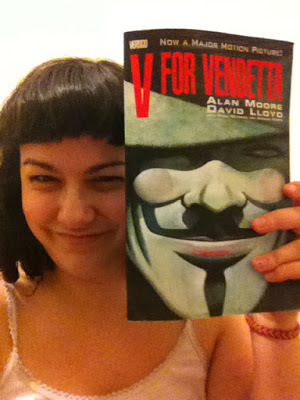
12. DO YOU HAVE A PREFERRED TIME TO READ WHEN REVIEWING A BOOK?I have a toddler, so I read whenever I get the chance, which is usually during her nap time and right before I go to bed.
13. DO YOU HAVE A FAVOURITE PLACE TO READ?The best place to read is in my comfy bed.
14. WHAT IS YOUR GREATEST JOY IN WRITING A BOOK REVIEW?My greatest joy in writing a book review (especially if I really loved the book) is sharing the experience I have just had with my readers. I also take pride in the quality of my book reviews, and this sometimes means being honest about really poorly-written books, but I am happy knowing I am providing my readers with a source to help guide them through the many books that are out there these days: which I think would be great to read, which I recommend should be avoided.
15. WHO IS YOUR FAVOURITE ALL TIME AUTHOR? WHY?That is one of the hardest questions I have ever had to answer! It’s like asking someone what their favourite song or movie is. There are so many! A few of my favourites are Ted Dekker, George R.R. Martin, J.R.R. Tolkien, C.S. Lewis, Meg Cabot, Emily Dickinson, Edna St. Vincent Millay, Victor Hugo, Jimmy Olsen, Kay Redfield Jamison and Fyodor Dostoyevsky.
16. WHAT’S THE GREATEST COMPLIMENT YOU EVER RECEIVED FROM A WRITER YOU REVIEWED?The best compliment I ever received from a writer I reviewed was from Jimmy Olsen, who praised the quality of my writing style and the thoroughness with which I captured the spirit of his various books. It meant a lot to me because he is one of the best writers I have discovered through reviewing, and has been perfecting his craft for a long time.
17. WHAT WAS THE WORST COMMENT FROM A WRITER YOU REVIEWED?I’ve honestly never really gotten any bad comments from writers. I have gotten some complaints that my reviews were taking too long, but considering that I get through the books as fast as I can considering the other things I have taking up my day, and how thorough I am when reading/reviewing them, and the fact that I do this and then write an article about it all for free, I try to be as mindful of time as possible and maintain good communication with the authors, but I really don’t let those comments bother me too much because the final product takes time, and I think that shows on my blog.

18. WRITERS ARE SOMETIMES INFLUENCED BY THINGS THAT HAPPEN IN THEIR OWN LIVES. ARE YOU AS A BOOK REVIEWER?Yes. Absolutely. I have Bipolar Disorder and Borderline Personality Disorder, and I have been through a lot and worked really really hard to be where I am today, so part of why I am so interested in psychologically-based literature is because I have lived it, and through my own life experience, I am something of an expert. If someone is trying to glamourize mental illness or stigmatize people with mental health problems, it will definitely stand out very clearly to me, and that’s the sort of thing I don’t stand for as a book reviewer. I’m not talking about maybe having a protagonist say negative things or treat someone badly who is depressed or even using the words ‘bipolar’ or ‘OCD’ as adjectives. I am talking about authors who think that it’s okay to romanticize or take lightly things like suicide, or who are clearly uneducated on psychiatric matters. I’m talking about writers who center stories around ‘crazy’ individuals, giving them diagnoses with symptoms that don’t match, attaching negative stigma to those diagnoses, that sort of thing. I have actually reviewed a book where all of those things happened at once, and it was probably an unpleasant experience for the author to read my review.
19. HOW MANY BOOKS HAVE YOU REVIEWED?On my blog, I have officially reviewed 18 books, but before I got as serious about book reviewing, I had many star-rating one-sentence reviews on my old Goodreads account.
20. OTHER THAN READING, WHAT ELSE DO YOU LOVE?Good food and drink. Seriously. It just goes so well with reading! As long as I don’t get anything on the pages! (Yes, I prefer to read hard copies).
I also love Doctor Who. A lot. I basically watch Doctor Who and read books every single day of my life and it’s been that way since I was pregnant with my daughter in 2013 (there are a lot of episodes of Doctor Who). But anything on Netflix is basically a hobby of mine. Shows and movies are basically just books with moving, talking pictures, so it’s pretty clear why I’d be into that.I also love trying new things. I might go to a workshop on how to repair and maintain my bicycle, I might go to the museum or the art gallery or the library, or I might go to a board game café and try to kick my husband’s butt at 90s Trivial Pursuit like I did last night! Who knows what I might try next?I love the arts. Theatre, concerts of any kind, ballet. I will see them all. I am also very interested in film history, fashion history and Russian literature. And anything to do with South Korea or Japan.I also have an unholy addiction to the Sims 3 games. Once I’m in, I won’t be out for hours.
21. DO YOU ALSO WRITE?What, my articles aren’t good enough for you? You want more??? Well, good! Because I happen to also write poems and short stories on the side and I have been working on a novel for a really long time. It’s not even remotely near being finished, of course. But sometimes I do actually write outside the blogosphere, yes.
22. ARE SOME BOOKS DIFFICULT TO REVIEW? WHY?Yes. I find books written by friends to be difficult to review because there is that element of someone’s feelings getting hurt if they are not a person who takes constructive criticism very well (no matter how good a writer they are). I also find very poorly written books to be frustrating, especially when I can see that the author had so much more potential and was just being lazy. As well, my book reviewing process is very thorough, so nonfiction books with a lot of names and dates take extra time because I truly try to take in what I read, and it’s hard to explain to some people why it can take so long for one book when someone else gave them a 5 star review in two days.
23. DESCRIBE YOUR PERFECT DAY.My perfect day consists of sleeping in, having a delicious breakfast brought to me in bed, going with my closest girlfriend to a salon to get my eyebrows done, getting a massage and a mani-pedi, then going for authentic dim sum for a late lunch. After lunch, we will have the house to ourselves (save for the housecleaning staff who will be making it spotless for us) and we will read, colour, watch Netflix, and cuddle with my kitty. After she leaves, I will then be having a fancy dinner somewhere nice with my husband, after which we will go shopping and purchase lovely clothes and accessories for ourselves and our daughter, who has been enjoying the entire day with the modern-day equivalent of Mary Poppins, and items for our home. We will have a Jacuzzi, and after Ivy is asleep, Graham and I will relax in it with some wine, then get into our giant four-poster bed with eiderdown quilts and feather mattress and go to sleep. *sigh* It’s so relaxing just thinking about it.
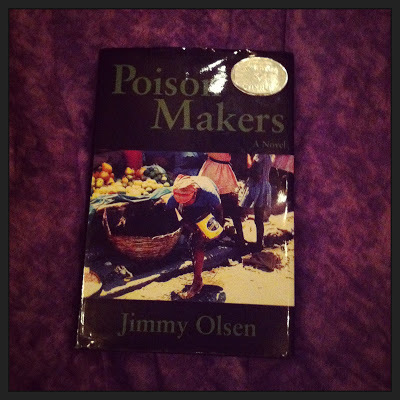
24. WHAT ARE YOUR PLANS FOR THE FUTURE?I plan to build my portfolio and continue writing quality book reviews until I have enough to present to editors at a paying publication. I also wish to travel more and see more of Canada, especially the northern parts of it, since I lived in northern Manitoba as a young girl and have always wanted to go back up there. Travelling and possibly immigrating to the UK has always been a dream of mine as well. Most importantly, I hope to somehow be able to share my voice with the world, and to live a life meaningful enough for my daughter to learn and grow by. I hope to inspire people and to help guide them if possible. I want, in my own small way, to make the world a better place.

BLOG

Clancy's comment: Well done, SharaLee. Get cracking on that book. Time waits for no author.
I'm ...


Published on November 07, 2015 01:32
November 6, 2015
7 November 2015 - WHO WAS THE YELLOW ROSE OF TEXAS?

WHO WASTHE YELLOW ROSE OF TEXAS?
G'day folks,
You might find this interesting. Emily D. West, also known as Emily Morgan, is a folk heroine whose legendary activities during the Texas Revolution have come to be identified with the song "The Yellow Rose of Texas".
In the fall of 1835, a free African-American woman from Connecticut named Emily D. West signed a one-year contract with Colonel James Morgan to work as a housekeeper in New Washington (later known as Morgan’s Point), a small settlement in Texas. In mid-April 1836, Mexican troops commanded by General Antonio López de Santa Anna arrived at New Washington. After looting and burning the settlement, Santa Anna and his soldiers forced Emily West to accompany them when they left several days later. According to legend, West was in Santa Anna’s tent on April 21, when Sam Houston’s Texian Army charged the Mexican camp in the Battle of San Jacinto. Some believed she was acting as a Texian spy, and had intentionally helped the rebel cause by keeping Santa Anna occupied before the attack.
There is little historical evidence to support this story. If West was in fact with Santa Anna when Texians charged the Mexican camp, it was probably not by choice; she could not have known of Houston’s plans or intentionally delayed the Mexican general. The only written record of the incident is a diary entry written by William Bollaert, a British traveler, in 1842, identifying the woman in question as “a mulatta girl (Emily) belonging to Col Morgan.” No official record from the Battle of San Jacinto mentioned a woman being found in Santa Anna’s tent, and though a number of Santa Anna’s officers publicly criticized him for losing Texas, not one ever accused him of being distracted by a woman at San Jacinto. For her part, Emily West is thought to have applied for and received a passport to return home to New York in 1837.
Only much later, in the mid-20th century, would West (sometimes misidentified as Emily Morgan) be linked with the popular song “The Yellow Rose of Texas,” which was apparently composed in the 1850s by a songwriter identified only as “J.K.” Though West’s connection with the song has no basis in fact, the association became so powerful that many scholars accepted it as authentic.

Clancy's comment: Mm ... There ya go.
I'm ...
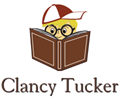

Published on November 06, 2015 02:07
November 5, 2015
6 November 2015 - SINEAD O'CONNOR

SINEAD O'CONNOR
G'day folks,
Sinéad Marie Bernadette O'Connor is an Irish singer-songwriter who rose to fame in the late 1980s with her debut album The Lion and the Cobra. With her signature shaved head, Sinead O'Connor emerged with a powerful and expressive voice, complex songs, and a fair share of controversy.
Born on December 8, 1966, in Dublin, Ireland, Sinead O'Connor started her music career began when she was discovered by a local drummer. With fame came controversy: Among other incidents, when appearing on Saturday Night Live, O'Connor tore up a picture of the pope. Whether or not such controversy damaged her career, O'Connor has not released an album since 2000.

Singer-songwriter. Born December 8, 1966, in Dublin, Ireland. After a difficult childhood (her parents divorced early on and her mother was frequently abusive), O'Connor was sent to reform school after being caught shoplifting. Her music career began when she was "discovered" by the drummer of the popular Irish band In Tua Nua and co-wrote their hit song "Take My Hand." Before finishing school, O'Connor ran away to Dublin, where she sang and played guitar on the street and in pubs and worked for a singing telegram service.
While performing with a Dublin band called Ton Ton Macoute, O'Connor caught the attention of the two owner-managers of a small London record label called Ensign Records. Ensign released her debut album, The Lion and the Cobra, late in 1987. Critics lauded O'Connor's powerful and expressive voice and noted the complexity of her songs, even while acknowledging their decidedly uncommercial nature. Though it had no major hit singles, the album eventually sold over 500,000 copies and went platinum.
With the 1990 release of O'Connor's second album, I Do Not Want What I Haven't Got, the bald-headed singer-songwriter became an international star. Driven by the phenomenal success of the smash hit single "Nothing Compares 2 U" (a once-obscure song written by Prince and first recorded by a band called the Family), the album shot to the top of the Billboard charts and nabbed O'Connor four Grammy Award nominations including Best Album, Best Song, Best Female Vocalist, and Best Alternative Album. The video for "Nothing Compares 2 U" won the MTV Award for Video of the Year, and O'Connor was named Artist of the Year in 1991 by Rolling Stone.
Her next two albums, Am I Not Your Girl? (1992) and Universal Mother(1994), made far less of an impact either critically or commercially. Soon, however, O'Connor became famous for her controversial public outbursts, beginning in 1989 when she announced her support for the radical Irish Republican Army (IRA); she retracted the statement one year later. She again made headlines in 1990 when she refused to appear onstage in New Jersey if "The Star-Spangled Banner" were played before the concert. In 1991, O'Connor boycotted the Grammy ceremony and refused her award for Best Alternative Album, maintaining that her absence was a protest against the extreme commercialism of the Grammy Awards.
Even more publicity surrounded a 1992 performance by O'Connor on Saturday Night Live, during which she tore up a photograph of Pope John Paul II, denouncing the Catholic Church as "the real enemy." Despite her contempt for the clerical hierarchy, O'Connor maintained she was a Catholic and devoutly spiritual.

Changes and Challenges
Aside from the release of her 1997 single, Gospel Oak, O'Connor's recording career faltered in the late 1990s, eclipsed by the turmoil in the singer's private life. In 1995, an extended custody battle began between O'Connor and her ex-lover, Irish journalist John Waters, over their infant daughter, Roisin. Plagued by Waters' bitter accusations that she was an unfit mother, O'Connor attempted suicide in March 1999. While recovering, O'Connor agreed to let Roisin live with Waters in Dublin. A few days later, however, she snatched the girl from Waters' home and flew with her back to London. (In addition to Roisin, O'Connor has a son, Jake, with her first husband John Reynolds.)
Less than a month later, O'Connor made headlines in an altogether different way-in April 1999, she was ordained as the first-ever priestess of the Latin Tridentine Church, a dissident Catholic group led by a self-styled Roman Catholic bishop from Ireland named Michael Cox. In April 2000, Mother Bernadette Marie (O'Connor's clerical name) was elevated to Archdeacon for her work with Dublin's homeless.
In 2000, O'Connor signed with Atlantic Records. Her first album in six years, Faith & Courage, was released later that year. Her personal life made headlines the following year. After a whirlwind romance, O'Connor married the British journalist Nick Sommerlad in a secret ceremony in the summer of 2001. But this union did not last. The pair soon split up. She went on to release an album of traditional Irish music, Sean-Nós Nua, in 2002.
O'Connor announced that she was retiring from music in 2003. She Who Dwells in the Secret Place of the Most High Shall Abide Under the Shadow of the Almighty(2003) was supposed to be her last album. According to People magazine, O'Connor posted this message on her website: "I am a very shy person, believe it or not. So I ask with love, that I be left in peace and privacy by people who love my records too." She welcomed a third child, a son named Shane, with musician Donal Lunny around this time.

In Recent Years
O'Connor did not retire from the music scene for long. In 2005, she released the reggae-influenced Throw Down Your Arms.
O'Connor continued to produce new music with 2007's Theology and add to her family. She gave birth to her fourth child, Yeshua Bonadio, that same year. Yeshua's father is Frank Bonadio.
In 2010, O'Connor once again tried for wedded bliss. She married friend and frequent collaborator Steve Cooney that year, but the union didn't last. The pair called it quits the following spring. Undeterred from finding her happily ever after, O'Connor married for the fourth time in December 2011. She and Barry Herridge tied the knot in Las Vegas, but she announced that the marriage was over after only 18 days.
Despite her rocky personal life, O'Connor earned strong reviews for her 2012 effort How About I Be Me (And You Be You)?. Her next record, I'm Not Bossy, I'm the Boss (2014), also received a warm reception. O'Connor also continues to perform in concert with several dates scheduled around the world in 2015.

Clancy's comment: Mm ... Singers, poets and writers have always used their craft to send a message in one way or another. Wow, married four times!
I'm ...


Published on November 05, 2015 01:14
November 4, 2015
5 November 2015 - Amazing Bounce of ‘The Rabbit Who Wants to Fall Asleep’
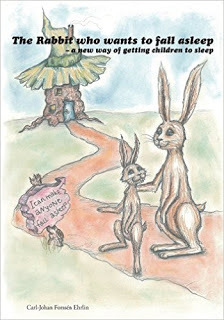
Amazing Bounce of ‘The Rabbit Who Wants to Fall Asleep’
G'day folks,
Here is a great success story for you self-published authors, courtesy of Publishers Weekly.
It’s been quite a week (or two) for Carl-Johan Forssen Ehrlin. The author of a heretofore unknown Swedish picture book, which mysteriously shot to the top of Amazon’s U.K. print bestseller list on August 13, now has a bona fide hit on his hands. The question that remains, though, is how Forssen Ehrlin’s 28-page book, The Rabbit Who Wants to Fall Asleep, became, literally, an overnight success.
Forssen Ehrlin self-published through Amazon’s CreateSpace, releasing an English-language edition of the book in the U.S. in April 2014. Rabbit’s quick rise to international attention seems to have been sparked by an August 14 article in the U.K. newspaper the Daily Mail. The article credited the book’s success to Forssen Ehrlin’s claim that the title could ease parents’ bedtime routine; its headline referred to the “book that’ll send your kids to sleep.” The Mail article also noted that Rabbit had accomplished a remarkable feat, becoming the first self-published book to hit #1 on Amazon’s U.K. print list.
The Mail article then begot other coverage, with stories about Rabbitfollowing in Forbes, the Guardian, PW, and NPR, among others. Fewer than seven days after the Mail story, with sales of the book skyrocketing, Forssen Ehrlin signed with the Salomonsson Agency, the powerful Swedish literary agency that represents such authors as Jo Nesbø. By the end of last week, PW learned that Random House paid seven figures for world English rights to Rabbit and two sequels. (At press time, no one at Random House would confirm the deal, though.)
There’s little question that the press attention the book has received—much of it seizing on the fact that the author self-published, and questioning whether the book really is the literary equivalent of pediatric Ambien—drove recent sales. In the U.S., Nielsen BookScan, which captures roughly 80%–85% of print sales, reported that Rabbit had sold 24 copies in the week ended August 16. By the following week, ended August 23, the title had sold more 29,000 copies. (Prior to August 23, BookScan shows the book sold roughly 300 copies in the U.S.)
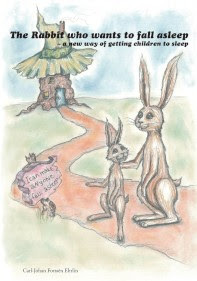
In the U.K., print sales of the book picked up earlier, but show a similar trajectory. According to BookScan (which also tracks sales in England), the title had sold 1,150 copies in the week ended August 8. By the end of the following week, on August 15, BookScan reported that Rabbit had sold 4,119 copies. Ben Spencer, a medical journalist with one of the bylines on the Daily Mail story about the book, told PW a source tipped him off to the fact that a self-published book was perched at the top of the Amazon list.
Rabbit’s rapid rise, on Amazon’s U.K. list—without seemingly any major marketing effort—has led to speculation that sales of the title may have been manipulated. (So-called manipulation of bestseller lists is something that authors and industry members are aware of, but there are few documented instances of the practice being successful on a large scale.
Nonetheless it is possible for someone who is willing to buy a large number of copies of a title over a short period to drive a book up a bestseller list, especially one like Amazon’s, which is updated hourly. In the case of Rabbit, it hit #1 on Amazon’s U.K. print list after a week in which its sales tallied just over 4,000 copies.) Amazon flatly denied this scenario, though.
“All sales activity around The Rabbit Who Wants to Fall Asleep was organic,” an Amazon spokesperson said.The spokesperson credited the book’s sudden popularity to U.K. parents talking about it on social media over the course of the summer, adding that this online chatter was the thing that “seems to be at the root of the book’s initial debut on the top 20 print list in the U.K.” Then, according to the spokesperson, once the book hit Amazon’s list, marketing and publicity efforts coordinated by the author caught the attention of the U.K. press.
According to research performed by social analytics platform Crimson Hexagon, the book was getting very little attention on blogs and social media outlets before the Mail’s August 14 story. The real jump in online mentions of the book came in the days immediately following the Mail story.
Since the book became a media sensation, Forssen Ehrlin has kept a low profile. A request made by PW, through the Salomonsson Agency, to interview the author was declined, with the explanation that Forssen Ehrlin has been overwhelmed by recent events.
Regardless of how Rabbit’s sales were initially generated, what the book’s meteoric rise proves once again is that the right kind of press attention can turn any book into a massive hit. In some ways Rabbitis reminiscent of Fifty Shade of Grey. E.L. James’s novel, which was released by a publisher so small it was considered self-published, also rode a wave of early press coverage. Both cases prove that, regardless of how the press machine gets going, once it does, it has the ability to turn a book into a phenomenon.

Clancy's comment: Mm ... You just never know, eh? I guess the secret is to hang in there ... And pray!
I'm ...
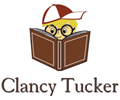

Published on November 04, 2015 02:29
November 3, 2015
4 November 2015 - K.J. McPIKE - Guest Author

K. J. McPIKE
- Guest Author -
G'day folks,
Today, I welcome you to another interview with an emerging author. K.J. McPike is an infant teacher turned author who loves all things paranormal. She grew up in rural Virginia and started writing stories as a way to escape small-town horrors like Drive Your Tractor To School Day, which was an official part of her high school's Spirit Week.
Since escaping said small town, she graduated from Penn State University and made a habit of moving across (and out of) the U.S. To date, she has lived in 11 different states and visited 9 countries. Despite her nomadic tendencies, she spends at least a few months out of the year in Seattle, where she regularly consumes too much caffeine and is more likely to be found in a coffee shop than her own apartment.
Welcome K.J ....
1. TELL US A LITTLE ABOUT YOURSELF AND YOUR WRITING JOURNEY.
I have always loved to write, and I started writing short stories at about ten years old—back when I thought it was cool to make all my characters’ names rhyme. Getting into my teenage years and early twenties, I began writing poetry and song lyrics, and I journaled like crazy. Even through the busy college years, I squeezed in creative writing courses wherever I could. Though reading has always been a big part of my life, the idea of writing a novel seemed overwhelming to me until I hit my mid-twenties. The inspiration for XODUSkind of hit me all at once, and I was so excited about writing the story that it suddenly didn’t matter how long it was, as long as I got to tell it.
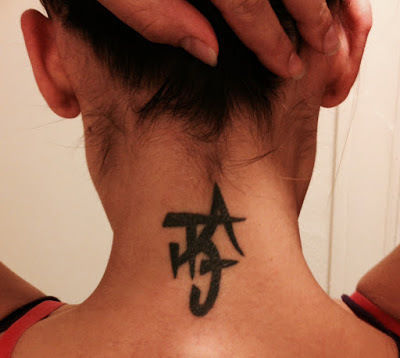
2. HOW DID YOU GET YOUR IDEA FOR YOUR MOST RECENT NOVEL?
Interestingly enough, the idea came to me while I was trying to map out the plot for a different book.
So, backstory: I have a tattoo on the back of my neck of a symbol I designed when I was in high school. The symbol combines the first initials of my four siblings with my own first initial. End backstory.
As I was thinking about where to take the storyline for the other novel, I started rubbing the back of my neck. Then it hit me that it would be really fun to write a book about five siblings and a symbol they shared that had some kind of mystical power. The idea of astral projection has always fascinated me, so that came to me right away. Everything else I originally planned transformed quite a bit through the writing process, but it all began with a tattoo and a little bit of writer's block.
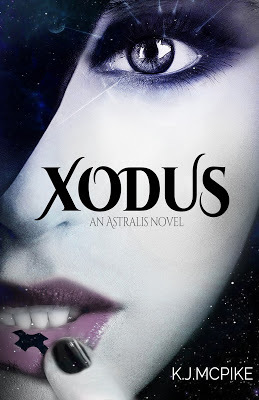
3. WHAT TYPE OF PREPARATION DO YOU DO FOR A MANUSCRIPT? DO YOU PLAN EVERYTHING FIRST OR JUST SHOOT FROM THE HIP?
Honestly, planning has never been my strong suit. I started writing XODUS without an outline, which may or may not be why it took me nearly three years to write it. It could’ve also been that I had a lot of learning to do about scene structure, story arcs, character development, etc. Whatever the cause, I know my journey with this book needed to happen the way it did so I could give this story the polished writing it deserves.
4. WHAT DO YOU ENJOY MOST ABOUT BEING A WRITER?
Sleeping in! No, I’m kidding. I actually have this really bad habit of not sleeping much at all when I’m in create-mode, but that’s beside the point. I love that writing gives me freedom of location. My family is spread out, and the fact that I can write from anywhere means I can visit the people I love for longer stretches of time without having to worry about running out of vacation hours.
5. WHAT IS THE HARDEST THING ABOUT BEING A WRITER?
Letting go. I suffer from a disease called perfectionism, and it is incredibly difficult for me to read something I’ve written and not want to change it. Therefore, it is really hard for me to feel like something is done and just let it go. There is a saying I love (and wish I could live by) that goes “Better done than perfect.” I’m trying to get to the place in my heart.
6. WHAT IS YOUR GREATEST WRITING ACHIEVEMENT?
Finishing a novel!
7. WHAT ARE YOU WORKING ON AT THE MOMENT?
I am working on the second book in my Astralis series, XODUS Genesis (see what I did there? ;) ). It will be coming out in the fall of 2016. I also dedicate some of my writing time to the first novella in the series, which will be told from a different character’s perspective just before, during, and just after the events that take place in XODUS.
8. WHAT GENRE DO YOU WRITE?
I write Young Adult Paranormal Fiction and Fantasy. (No, I don’t write about vampires or werewolves . . . at least, not yet.)

9. DO YOU HAVE ANY TIPS FOR NEW WRITERS?
Make time to read and write every day. Both are equally important.
Also, try not to go back and edit until you get to the end of your project. I spent so much time editing and perfecting scenes as I wrote them, only to find I had to cut them once XODUS was completed. Cutting scenes always seems to be heartbreaking, but it eases the pain if you didn't spend countless hours working on one before you give it the axe.
10. DO YOU SUFFER FROM WRITER’S BLOCK?
All the time! So far, the best remedy I've found is to close my laptop and use good old-fashioned pen and paper. I usually just start writing words on the page, even if those words have nothing to do with my project. I've been known to begin with things like "I have no idea what to write" and go from there (shout out to my tenth-grade English teacher, Ms. Stanley, for teaching me that trick). Once the pen gets moving, there's no stopping it. Best case scenario: I get back on track with my project. Worst case: I get my frustrations out. I figure it's win-win.
11. DO YOU HAVE A PREFERRED WRITING SCHEDULE?
I love to write first thing in the morning, when my brain is still in that fuzzy state. I read somewhere that you’re most creative right after you wake up, and I feel like that is true. Maybe it’s the power of suggestion, but it works for me. My brain also seems to think it’s okay to come up with tons of ideas in the wee hours of the morning, so I typically end up scribbling notes onto a pad beside my bed at two or three in the morning. I’m working on toning that down.
12. DO YOU HAVE A FAVOURITE WRITING PLACE?
There’s something about coffee shops that is just magical for getting the creativity going. Also, trains. If there’s a coffee shop area on the train, there’s no telling what can happen.
13. WHO IS YOUR FAVOURITE AUTHOR AND WHY?
Not that this will surprise anyone, but J.K. Rowling is my hero. She amazes me in just about every way, but I am was just floored by her world-building (I’ve never wanted to go anywhere as much as I wanted to go to Hogwarts.) and planning. The fact that she planned out the Harry Potter books so well that she was able to mention concepts in passing and two or three books later, make them major plot points is mind boggling to me, especially because planning and I have never been great friends. I’m also blown away by her ability to write in a way that entrances such a wide variety of people. It’s like she took the concept of a target audience and stabbed it to death with her mighty pen.
I have also recently discovered Tahereh Mafi, and I absolutely adore the way she writes. I’ve never seen so many jaw-dropping metaphors in such close proximity. She has such a poetic way of writing, and an incredible ability to say things in a way that you know exactly what she means, but you’ve never heard it put so beautifully before.
14. WHAT’S THE GREATEST COMPLIMENT YOU EVER RECEIVED FROM A READER?
One of my beta readers sent me emails as she read to give me feedback, and the second email she sent me said, “Love the book so far, I cleared over 300 pages in one sitting. I've only ever done that with the Harry Potter series, so this book is really great!!” Being mentioned in the same sentence as Harry Potter just about did me in.

15. WHAT WAS THE WORST COMMENT FROM A READER?
Well, my novel just came out, so I haven’t had time to rack up too many reviews (good or bad), but shortly after I finished the third draft of XODUS, someone told me that a major part of my plot felt deus ex machina. I put so much thought into making things line up the way they did, and hearing that was like a slap in the face. Luckily, that was pre-publication, so I was able to adjust the manuscript before it went public. Mwhahaha!
16. WRITERS ARE SOMETIMES INFLUENCED BY THINGS THAT HAPPEN IN THEIR OWN LIVES. ARE YOU?
I am definitely influenced by my own life. I have moved (and continue to move) a lot, and I weave pieces of people I see and meet into characters all the time. I also like to put lessons I’ve learned into stories so my characters can learn them, too. Anyone who knows me also knows that my family influenced a lot of the characters in XODUS. I grew up the second of five children, and Lali, the protagonist in the story, is the oldest of five children. The way the siblings banter back and forth is very similar to the way my siblings and I are when we are together. Writing the scenes with Lali and her brothers and sisters was actually one of the most fun parts of writing the story.
17. OTHER THAN WRITING, WHAT ELSE DO YOU LOVE TO DO?
I love to draw, and I love to sing (though not in front of people). I’m also a board game fiend, and I LOVE video games—perhaps too much.
18. WHAT DID YOU DO BEFORE YOU BECAME A WRITER?
I worked as an Infant/Toddler teacher for five years before I became a freelance writer. I loved working in Early Childhood Education, and I adored the children. My poor boyfriend had to listen to stories about my kids for hours. He took it like a champ, but in retrospect, I talked about them ALL the time. Sadly, moving around and working with children don’t mix well. It’s hard on children to have attachment figures leave, and it was heartbreaking for me to say good-bye to my kids. I was a sobbing mess whenever any of them aged out of my classroom—leaving an entire center permanently was just devastating.
19. DID YOU HAVE YOUR BOOK / BOOKS PROFESSIONALLY EDITED BEFORE PUBLICATION?
YES! Multiple times. Typos haunt my nightmares.
20. DESCRIBE YOUR PERFECT DAY.
People I love. Beach. Pen and paper.
21. WHAT ARE YOUR PLANS FOR THE FUTURE?
My master plan is to sell enough books to support myself while I write more books.
22. DO YOU SEE YOURSELF IN ANY OF YOUR CHARACTERS?
My protagonist in XODUSstarts out a lot like I was at sixteen. She is sarcastic, fiercely protective of her siblings, and she has a very black and white view of right and wrong. If only I’d been able to astral project at that age . . .

23. DOES THE PUBLISHING INDUSTRY FRUSTRATE YOU?
I find it frustrating that there is still a bit of a stigma surrounding self-published and indie books.
24. DID YOU EVER THINK OF QUITTING?
I definitely thought of quitting. It took me nearly three years to write XODUS, and there were days I wrote myself into corners or spent hours reworking scenes only to realize that the changes I made created major plot holes that would take even more hours to fix. Some days, I was convinced I would never finish my first novel. Thankfully, I loved the story world and the characters enough that I couldn’t bear the thought of not telling the story in my head.
25. HOW MUCH THOUGHT GOES INTO DESIGNING A BOOK COVER?
I can’t speak for everyone, but my perfectionism makes me a little obsessive about getting a book cover just right. Even though I knew right away the concept I wanted for the cover of XODUS, I went through several designs before it felt right, and choosing a font for the title was a nightmare. For the record, many fonts don’t seem to put a lot of thought into styling the letter X. So if anyone else out there is planning to title a book something that starts with that letter, you were warned.
26. WRITING IS ONE THING. WHAT ABOUT MARKETING YOU, YOUR BOOKS AND YOUR BRAND? ANY THOUGHTS?
Marketing books is probably just as hard, if not harder, than writing books. There are so many novels published every month that standing out is a constant battle. That is one of the reasons I was so picky about my cover design. No matter how many times you hear not to judge a book by its cover, the truth is that people do it all the time. Your cover has to make people want to pick up or click on your book. Your description has to convince people to open your book. You as an author have to sound like you are worth reading. It’s exhausting just thinking about it.
27. DESCRIBE YOURSELF IN FIVE WORDS.
Never want to grow up.
28. WHAT PISSES YOU OFF MOST?
Liars. Unless they are lying temporarily to pull of an epic surprise or trying to save a life, I cannot handle liars.
29. WHAT IS THE TITLE OF THE LAST BOOK YOU READ? GOOD ONE?
Schrödinger’s City by Matthew P.Buscemi. Great one.
30. WHAT WOULD MAKE YOU HAPPIER THAN YOU ARE NOW? CARE TO SHARE?
Finishing my second novel. And then my third. You get the idea.

KJ'S WEBSITE

Clancy's comment: Go, KJ. Keep travelling and keep writing. Can't do any harm, eh? Good luck with the next novel.
I'm ...

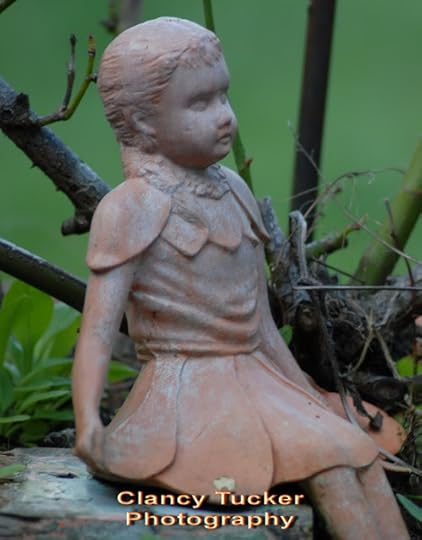
Published on November 03, 2015 01:42
November 2, 2015
3 November 2015 - SOME REALLY WISE TIPS

SOME REALLY WISE TIPS
G'day folks,
Here are some really wise tips and some humour thrown in to spark you up for the day.

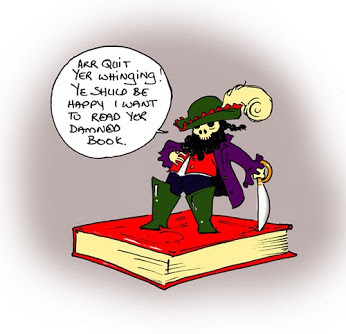

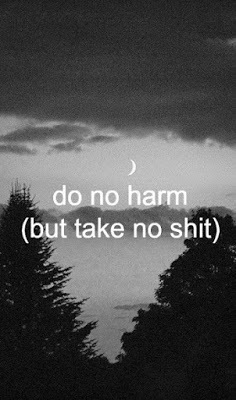

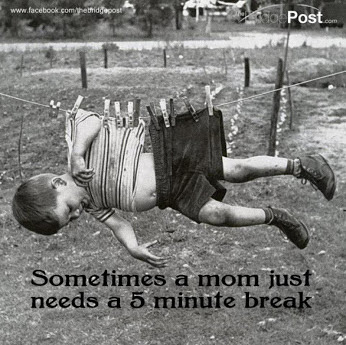


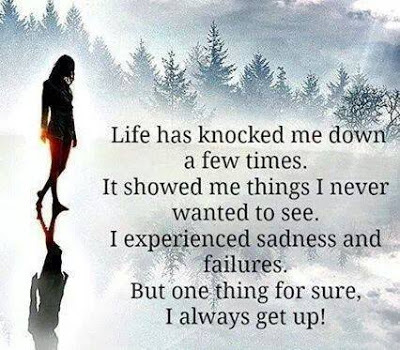








Clancy's comment: I hope some of these have fired you up for the day.
I'm ...
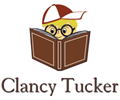

Published on November 02, 2015 02:11
November 1, 2015
2 November 2015 - CAROL MOSELY BRAUN - CIVIL RIGHTS ACTIVIST

CAROL MOSELY BRAUN
- CIVIL RIGHTS ACTIVIST -
G'day folks,
Welcome to the life of another outstanding woman. Carol Elizabeth Moseley Braun, also sometimes Moseley-Braun, is an American politician and lawyer who represented Illinois in the United States Senate from 1993 to 1999.
Carol Moseley Braun became the first African-American woman to be elected to the U.S. Senate in 1992.
Born on August 16, 1947, in Chicago, Illinois, Carol Moseley Braun was elected to the U.S. Senate in 1992, becoming the first black woman to earn that distinction. While in office, Moseley Braun was accused of misusing funds from her 1992 campaign, and she lost her next race. She joined the private sector in 2004.
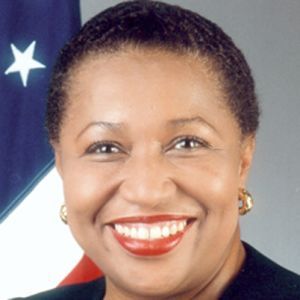
Carol Moseley Braun was born Carol Elizabeth Moseley on August 16, 1947, in Chicago, Illinois. A leading African-American politician, Moseley Braun's career has been marked by both great successes and missteps.
After graduating from the University of Illinois in 1969 with a degree in political science, Moseley Braun attended the university's law school. She earned her law degree in 1972, and began working as an assistant U.S. attorney in Chicago the following year.
Moseley Braun held her first political post as a Democratic representative to Illinois House of Representatives, beginning in 1978. As a representative, she was known as an advocate for social change, working for reforms in education, government, and healthcare. In 1988, she took another challenge. She was elected recorder of deeds for Cook County, Illinois, overseeing hundreds of employees as well as the public agency's multimillion-dollar budget.
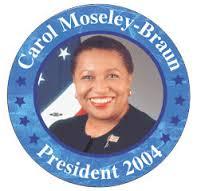
In 1992, Moseley Braun made the leap to the national political arena: She ran for a seat in the U.S. Senate, looking to unseat incumbent Democratic Senator Alan Dixon in the Democratic primary. Up against a seasoned politician who had spent decades in office, Moseley Braun appeared to be the underdog. But many responded to Moseley Braun as a chance for political change. She won the primary, but faced another tough opponent in Republican Richard Williamson. Williamson tried to capitalize on Moseley Braun’s mishandling of a tax situation. Although the scandal marred her campaign, she won the election, becoming the first African-American woman to win election to the U.S. Senate.
As a senator, Moseley Braun tackled many issues, including women's rights and civil rights. She served on several committees, including the powerful Senate Finance Committee. Moseley Braun continued to support educational reforms and called for more restrictive gun control laws. Her time in office, however, was affected by claims that she misused funds from her 1992 campaign, spending the money on personal expenses. While no charges were ever filed, this allegation clung to Moseley Braun as she sought re-election in 1998.
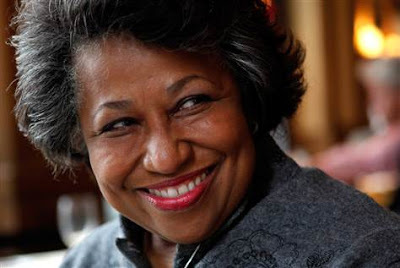
Moseley Braun's re-election campaign was also hindered by her Republican opponent Peter Fitzgerald. A self-financed candidate, Fitzgerald didn’t have restrictions on how much he could spend during his campaign. He won the election by a close margin. After leaving office, Moseley Braun was appointed U.S. ambassador to New Zealand and Samoa by President Bill Clinton in 1999. She left the post at the end of the Clinton Administration. A career-long advocate for education, Moseley Braun then taught at Morris Brown College.
In 2003, she campaigned for the Democratic presidential nomination.
Moseley Braun opposed the war in Iraq and spoke out about the country’s economic situation, but she dropped out of the race in early 2004 after failing to garner enough support. She asked her supporters to vote for Howard Dean.
Since then, Moseley Braun has been working as a business consultant and started an organic foods company called Good Foods Organics. She has one child: a son named Michael from her marriage to Michael Braun, which ended in divorce.

Clancy's comment: Mm ... Another great achiever.
I'm ...

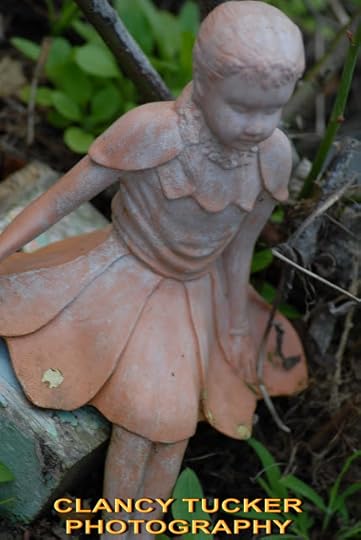
Published on November 01, 2015 02:47



